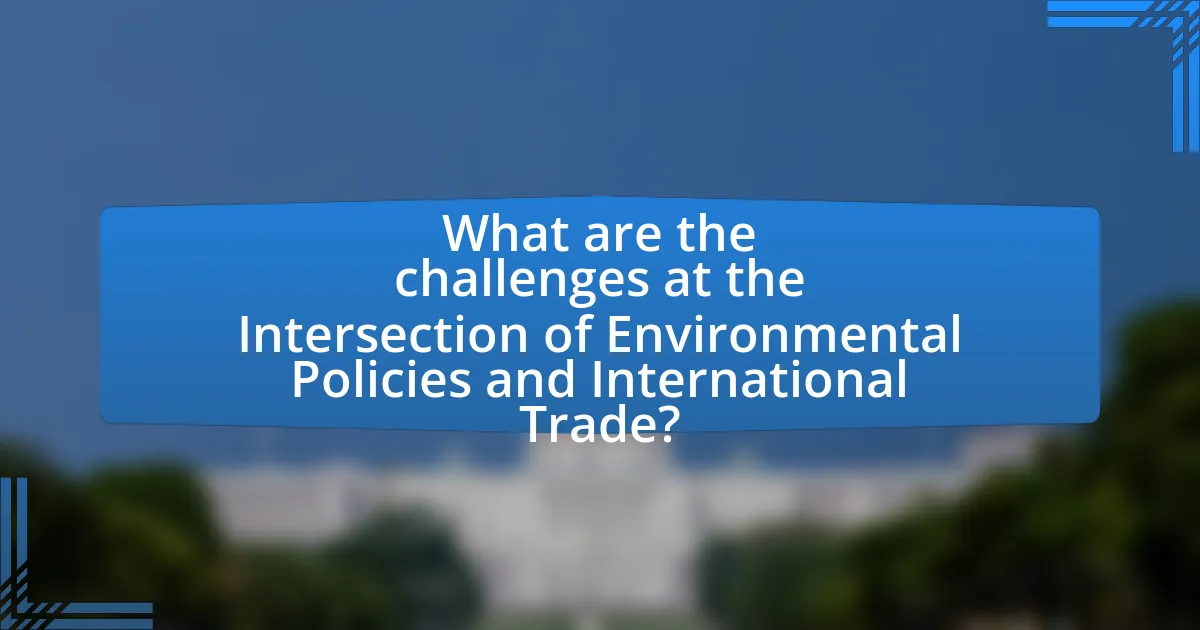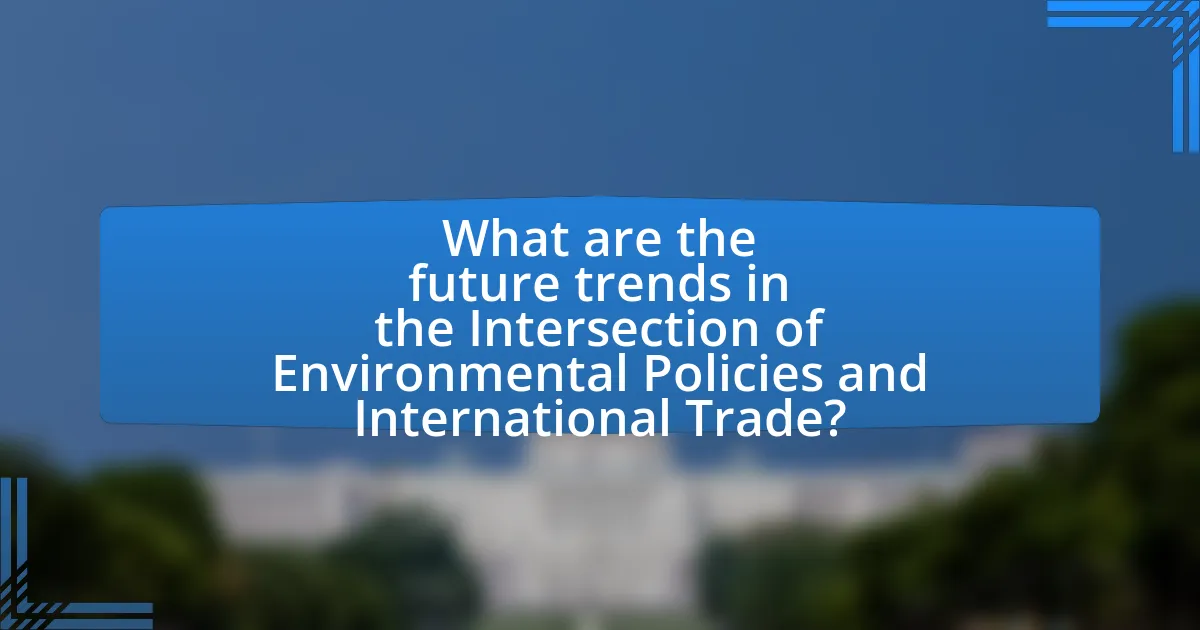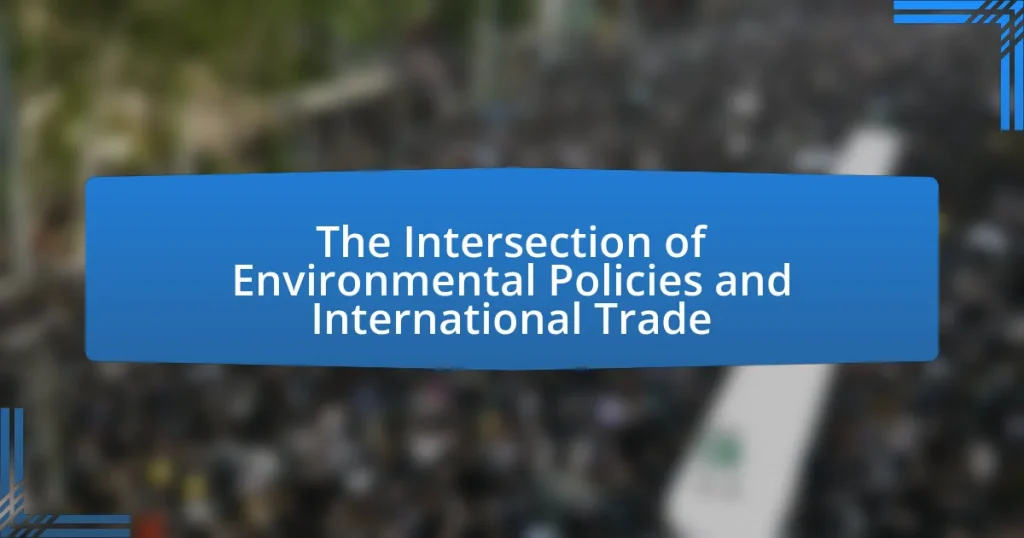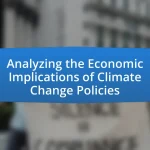The article examines the intersection of environmental policies and international trade, highlighting how regulations aimed at environmental protection influence global trade practices and vice versa. It discusses the impact of key environmental policies, such as the Paris Agreement and the Convention on Biological Diversity, on trade dynamics, including the imposition of tariffs and compliance costs for businesses. The article also addresses the challenges posed by differing national policies, the role of multinational corporations, and the strategies that developing countries can adopt to balance economic growth with sustainability. Additionally, it explores future trends, including carbon border adjustments and the integration of technology in promoting sustainable trade practices.

What is the Intersection of Environmental Policies and International Trade?
The intersection of environmental policies and international trade refers to the ways in which regulations aimed at protecting the environment influence and are influenced by global trade practices. Environmental policies, such as emissions standards and resource conservation measures, can affect trade by imposing restrictions on imports and exports, thereby shaping market dynamics. For instance, the World Trade Organization (WTO) allows member countries to implement trade measures that protect the environment, provided they do not constitute arbitrary or unjustifiable discrimination. This relationship is evident in agreements like the Paris Agreement, which encourages countries to adopt sustainable practices that can impact trade flows. Additionally, studies show that countries with stringent environmental regulations may face competitive disadvantages in international markets, prompting discussions on balancing trade liberalization with environmental sustainability.
How do environmental policies influence international trade practices?
Environmental policies significantly influence international trade practices by imposing regulations that affect the production, import, and export of goods. These policies can lead to increased costs for businesses that must comply with environmental standards, which may result in higher prices for consumers and altered trade flows. For instance, the European Union’s Emissions Trading System has created a market for carbon credits, impacting industries reliant on fossil fuels and encouraging a shift towards greener technologies. Additionally, countries may impose tariffs or trade restrictions on goods that do not meet specific environmental criteria, as seen in the case of the U.S. and its import bans on certain products linked to deforestation. Such measures can reshape global supply chains and encourage countries to adopt more sustainable practices to remain competitive in international markets.
What are the key environmental policies affecting trade?
Key environmental policies affecting trade include the Paris Agreement, which aims to limit global warming and encourages countries to adopt sustainable practices, and the Convention on Biological Diversity, which seeks to protect ecosystems and biodiversity. These policies influence trade by imposing regulations on carbon emissions and resource use, thereby affecting the competitiveness of industries. For instance, countries that adhere to stricter environmental standards may face higher production costs, impacting their trade balance. Additionally, trade agreements often incorporate environmental clauses that require compliance with specific environmental regulations, further intertwining trade and environmental policies.
How do trade agreements incorporate environmental considerations?
Trade agreements incorporate environmental considerations by including specific provisions aimed at promoting sustainable practices and protecting natural resources. These provisions often mandate adherence to environmental standards, encourage cooperation on environmental issues, and establish mechanisms for dispute resolution related to environmental matters. For example, the United States-Mexico-Canada Agreement (USMCA) includes commitments to uphold environmental laws and address issues such as air quality and biodiversity. Additionally, trade agreements may facilitate the exchange of information and best practices among countries to enhance environmental protection, reflecting a growing recognition of the interconnectedness of trade and environmental sustainability.
Why is the intersection of these two fields important?
The intersection of environmental policies and international trade is important because it shapes global economic practices while addressing environmental sustainability. This intersection ensures that trade agreements incorporate environmental standards, which can lead to reduced pollution and conservation of resources. For instance, the World Trade Organization (WTO) recognizes the need for trade policies that support sustainable development, as seen in the Doha Development Agenda, which emphasizes the importance of integrating environmental considerations into trade negotiations. By aligning trade practices with environmental goals, countries can promote sustainable economic growth and mitigate climate change impacts.
What are the potential consequences of neglecting environmental policies in trade?
Neglecting environmental policies in trade can lead to severe ecological degradation and increased greenhouse gas emissions. Without regulations, industries may exploit natural resources unsustainably, resulting in deforestation, loss of biodiversity, and pollution of air and water. For instance, the World Bank reported that unregulated trade practices contribute significantly to climate change, with global carbon emissions rising by 60% between 1990 and 2019 due to industrial activities. Additionally, neglecting these policies can create economic disparities, as countries with stringent environmental regulations may face competitive disadvantages against those that do not prioritize sustainability. This imbalance can hinder global efforts to combat climate change and protect the environment, ultimately affecting public health and economic stability worldwide.
How can sustainable trade practices benefit the environment?
Sustainable trade practices benefit the environment by reducing resource depletion and minimizing pollution. These practices promote the use of renewable resources, which helps preserve ecosystems and biodiversity. For instance, according to the World Trade Organization, implementing sustainable trade can lead to a decrease in carbon emissions by encouraging the adoption of cleaner technologies and sustainable sourcing methods. Additionally, sustainable trade practices often include stricter environmental regulations, which can lead to improved waste management and reduced environmental degradation.

What are the challenges at the Intersection of Environmental Policies and International Trade?
The challenges at the intersection of environmental policies and international trade include regulatory discrepancies, trade barriers, and the potential for environmental dumping. Regulatory discrepancies arise when countries implement varying environmental standards, leading to confusion and compliance difficulties for businesses operating internationally. Trade barriers, such as tariffs on environmentally friendly products, can hinder the adoption of sustainable practices. Additionally, environmental dumping occurs when countries with lax environmental regulations export goods at lower prices, undermining efforts to promote sustainability globally. These challenges complicate the alignment of trade practices with environmental goals, as evidenced by the World Trade Organization’s ongoing debates on how to integrate environmental considerations into trade agreements.
What conflicts arise between trade liberalization and environmental protection?
Trade liberalization often conflicts with environmental protection due to the prioritization of economic growth over ecological sustainability. As countries reduce tariffs and trade barriers to promote free trade, they may encourage practices that lead to environmental degradation, such as increased carbon emissions from transportation and production, deforestation for agricultural expansion, and overexploitation of natural resources. For instance, the World Trade Organization has noted that trade can lead to a “race to the bottom” in environmental standards, where countries lower regulations to attract foreign investment. This dynamic creates a tension between the goals of enhancing trade and the necessity of safeguarding the environment, as seen in cases where multinational corporations exploit lax environmental laws in developing countries to maximize profits.
How do differing national policies create trade barriers?
Differing national policies create trade barriers by establishing regulations that can restrict or complicate the flow of goods and services between countries. For instance, environmental policies may require specific standards for emissions or waste management that differ significantly from one nation to another. These discrepancies can lead to increased compliance costs for exporters, making it more difficult for them to enter foreign markets. According to the World Trade Organization, such non-tariff barriers, including differing safety and environmental standards, can account for up to 70% of trade barriers faced by businesses. This illustrates how national policies can directly impact international trade dynamics by creating obstacles that hinder market access.
What role do multinational corporations play in these conflicts?
Multinational corporations significantly influence conflicts related to environmental policies and international trade by prioritizing profit over sustainable practices. These corporations often engage in practices that lead to environmental degradation, such as deforestation and pollution, which can exacerbate tensions in regions where natural resources are contested. For instance, the extraction of minerals in conflict zones, like coltan in the Democratic Republic of the Congo, has been linked to human rights abuses and armed conflict, driven by the demand from multinational companies for these resources. Additionally, these corporations may lobby against stringent environmental regulations, undermining efforts to address climate change and protect ecosystems, thereby intensifying conflicts between economic interests and environmental sustainability.
How do developing countries navigate these challenges?
Developing countries navigate the challenges of environmental policies and international trade by implementing adaptive strategies that balance economic growth with sustainability. These countries often prioritize capacity building, enhancing local governance, and fostering international cooperation to meet environmental standards while remaining competitive in global markets. For instance, many developing nations engage in partnerships with international organizations to access funding and technical assistance, which helps them adopt cleaner technologies and improve regulatory frameworks. According to the World Bank, investments in sustainable practices can lead to increased resilience and economic opportunities, demonstrating that strategic alignment of environmental policies with trade objectives can yield positive outcomes for developing economies.
What strategies can developing nations employ to balance trade and environmental goals?
Developing nations can employ strategies such as implementing sustainable trade policies, investing in green technologies, and promoting eco-friendly products to balance trade and environmental goals. Sustainable trade policies can include tariffs on environmentally harmful imports and incentives for exports that meet environmental standards, which encourages local industries to adopt greener practices. Investing in green technologies not only enhances productivity but also reduces environmental impact, as seen in countries like Costa Rica, which has successfully integrated renewable energy into its economy. Additionally, promoting eco-friendly products can open new markets and attract consumers who prioritize sustainability, thereby enhancing trade while protecting the environment.
How do international organizations support developing countries in this context?
International organizations support developing countries by providing financial assistance, technical expertise, and policy guidance to enhance their capacity for sustainable development and environmental protection. For instance, the World Bank offers funding for projects that promote renewable energy and sustainable agriculture, which are crucial for balancing economic growth with environmental sustainability. Additionally, organizations like the United Nations Environment Programme (UNEP) facilitate knowledge sharing and capacity building, helping these countries implement effective environmental policies that align with international trade agreements. This support is vital as it enables developing nations to meet global environmental standards while fostering economic development, ultimately contributing to their integration into the global economy.

What are the future trends in the Intersection of Environmental Policies and International Trade?
Future trends in the intersection of environmental policies and international trade include the increasing implementation of carbon border adjustments and the rise of sustainable trade agreements. Carbon border adjustments are being adopted by countries to impose tariffs on imported goods based on their carbon emissions, aiming to level the playing field for domestic industries that adhere to stricter environmental regulations. For instance, the European Union’s proposed Carbon Border Adjustment Mechanism seeks to reduce carbon leakage and encourage global emission reductions. Additionally, sustainable trade agreements are gaining traction, as nations prioritize environmental standards in trade negotiations, reflecting a shift towards integrating sustainability into trade policies. This trend is evidenced by agreements like the Comprehensive and Progressive Agreement for Trans-Pacific Partnership, which includes provisions for environmental protection.
How is climate change shaping international trade policies?
Climate change is significantly shaping international trade policies by prompting countries to adopt regulations that prioritize sustainability and reduce carbon emissions. As nations recognize the economic impacts of climate change, they are increasingly implementing trade agreements that include environmental standards, such as the Paris Agreement, which encourages countries to commit to reducing greenhouse gas emissions. For instance, the European Union has introduced the European Green Deal, which aims to make Europe climate-neutral by 2050 and influences trade policies by imposing carbon border adjustments on imports to ensure that foreign producers adhere to similar environmental standards. This shift towards integrating climate considerations into trade policies reflects a growing consensus that environmental sustainability is essential for long-term economic stability and competitiveness in global markets.
What new regulations are emerging in response to climate change?
New regulations emerging in response to climate change include carbon pricing mechanisms, emissions reduction targets, and stricter environmental standards for industries. For instance, the European Union’s Green Deal aims to achieve net-zero greenhouse gas emissions by 2050, implementing a carbon border adjustment mechanism to prevent carbon leakage. Additionally, countries like Canada and New Zealand have introduced comprehensive carbon pricing frameworks that incentivize emissions reductions across various sectors. These regulations are designed to align economic activities with climate goals, reflecting a global shift towards sustainable practices in international trade.
How are businesses adapting to these changes?
Businesses are adapting to changes in environmental policies and international trade by implementing sustainable practices and enhancing supply chain transparency. Many companies are investing in green technologies and renewable energy sources to reduce their carbon footprint, aligning with stricter regulations and consumer demand for eco-friendly products. For instance, a report by McKinsey indicates that 70% of companies are prioritizing sustainability in their operations to meet both regulatory requirements and market expectations. Additionally, businesses are increasingly collaborating with stakeholders to ensure compliance with international environmental standards, which helps them maintain competitiveness in global markets.
What role does technology play in this intersection?
Technology plays a crucial role in the intersection of environmental policies and international trade by enabling the development and implementation of sustainable practices. Innovations such as renewable energy technologies, waste management systems, and carbon capture solutions facilitate compliance with environmental regulations while enhancing trade efficiency. For instance, the adoption of advanced agricultural technologies can reduce resource consumption and emissions, aligning with both environmental goals and trade competitiveness. Additionally, data analytics and blockchain technology improve transparency in supply chains, ensuring adherence to environmental standards across borders. These technological advancements not only support the enforcement of environmental policies but also promote sustainable economic growth in international trade contexts.
How can innovations in technology promote sustainable trade practices?
Innovations in technology can promote sustainable trade practices by enhancing efficiency, reducing waste, and enabling better resource management. For instance, blockchain technology improves transparency in supply chains, allowing businesses to track the origin and sustainability of products, which can lead to more responsible sourcing. Additionally, advancements in artificial intelligence optimize logistics, reducing carbon emissions associated with transportation. According to a report by the World Economic Forum, implementing digital technologies in trade can reduce global emissions by up to 20% by 2030. These technological innovations not only facilitate compliance with environmental regulations but also encourage businesses to adopt sustainable practices, ultimately fostering a more sustainable global trade environment.
What examples exist of technology improving environmental compliance in trade?
Technology has significantly improved environmental compliance in trade through the implementation of blockchain, IoT sensors, and AI analytics. Blockchain technology enhances transparency and traceability in supply chains, allowing companies to verify the sustainability of their products and ensure adherence to environmental regulations. For instance, IBM’s Food Trust blockchain enables stakeholders to track the origin and journey of food products, ensuring compliance with safety and environmental standards.
IoT sensors monitor environmental conditions in real-time, providing data that helps companies comply with regulations. For example, sensors can track emissions levels in manufacturing processes, alerting companies when they exceed legal limits. This proactive approach allows for immediate corrective actions, thereby maintaining compliance.
AI analytics further supports compliance by analyzing large datasets to identify patterns and predict potential environmental risks. Companies like Envirosuite utilize AI to assess environmental impacts and ensure adherence to regulations, thus improving overall compliance in trade practices. These technologies collectively foster a more sustainable and compliant trading environment.
What best practices can countries adopt to harmonize trade and environmental policies?
Countries can harmonize trade and environmental policies by implementing integrated policy frameworks that align economic growth with sustainable practices. These frameworks should include the adoption of environmental standards in trade agreements, which can facilitate the reduction of trade barriers for environmentally friendly products. For instance, the European Union’s Green Deal emphasizes sustainability in trade, promoting eco-friendly goods while imposing stricter regulations on harmful imports. Additionally, countries can engage in multilateral agreements that set common environmental goals, such as the Paris Agreement, which encourages nations to commit to reducing carbon emissions while considering trade implications. Evidence shows that countries that adopt such practices can enhance competitiveness and foster innovation in green technologies, as seen in the rise of renewable energy sectors in nations like Germany and Denmark.


